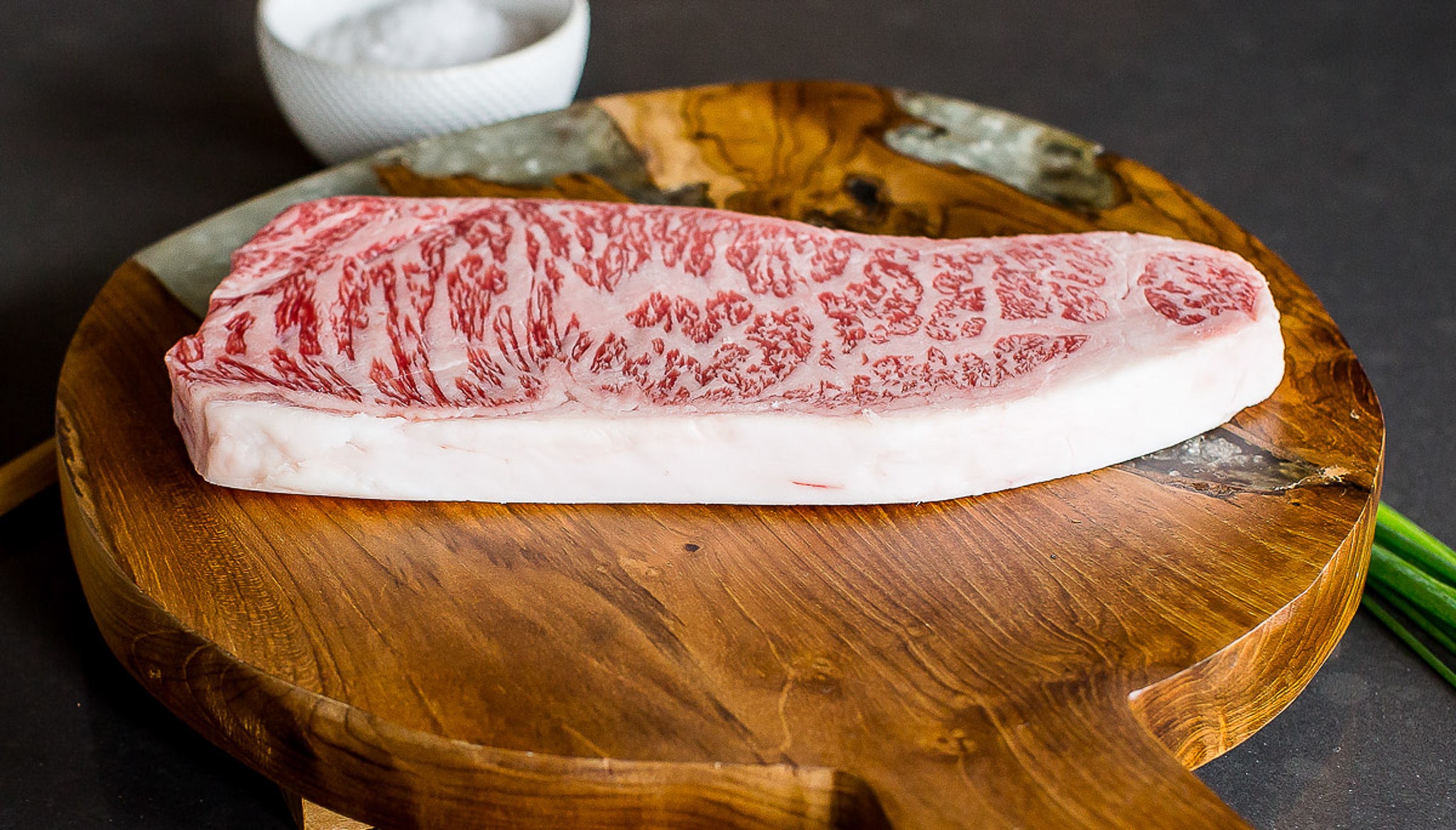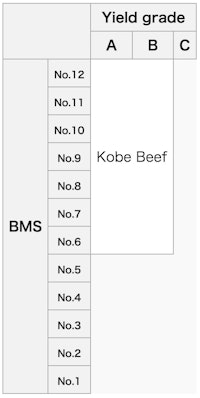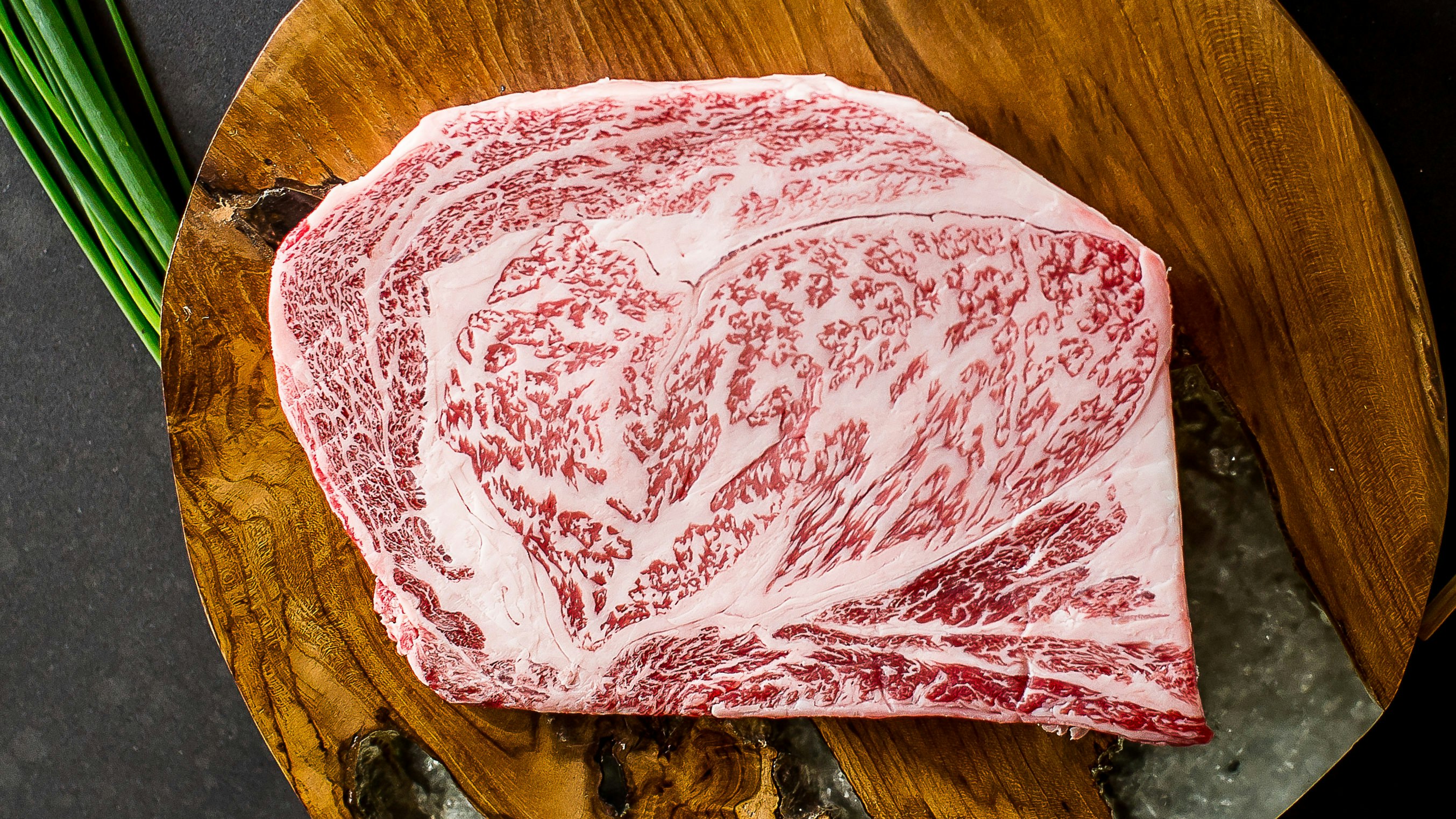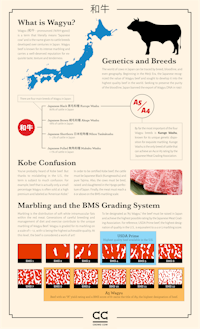
What's Wagyu? Wagyu is, quite simply, the most sought after beef in the world -- and the subject of much confusion, thanks to the frequent misuse of the term "Kobe beef" in this country.
We set out to discover the truth about Wagyu. This article is the result of research conducted from Japanese language original sources and first-hand interviews with experts including one of the original people responsible for bringing Wagyu to the United States in the 1970's and the President of the American Wagyu Association, whose Wagyu breeding facilities are world-renowned. We have also, of course, met directly with Purebred and Fullblood Wagyu ranches, dedicated to producing the highest quality beef available in this country.
"Wagyu" (和牛 - pronounced /WAH-gyoo/) is a term that literally means “Japanese cow” and is the name given to cattle breeds developed over centuries in Japan. They are considered a national treasure there and no longer exported. Wagyu beef is legendary for its intense, perfect marbling and carries a well-deserved reputation for superior taste, texture and tenderness.
Wagyu originated from Asian cattle breeds and were bred for centuries as working animals to plow fields. As a result of their natural environment and working conditions, over time they developed a unique natural ability to store extra energy as a fine, evenly-distributed intra-muscular fat -- marbling with an intensity and level unique to the breed. Beginning in the Meiji era, Japan recognized the value and quality of this meat, and sought to develop Wagyu into the finest quality beef through highly regulated breeding programs over many decades.
Wagyu in Japan

For a bit of context, the world of cows in Japan can be broken down by breed, bloodline and even geography. Lots of misinformation exists online, so we’ve consulted Japanese language authoritative resources to lay it all out and remove any misnomers or confusion.
There are four main meat-producing breeds of Japanese Cattle (和牛 - “Wagyu”):
- Japanese Black (黒毛和種 / Kurogewashu) - they are monochromatic black tinged with brown, and often pale under the body and inside the legs. These account for over 80% of cattle in Japan.
- Japanese Brown (褐毛和種 / Akagewashu) - of a more tan monocromatic color, these are slighly larger than the Japanese Black.
- Japanese Shorthorn (日本短角種 / Nihon Tankakushu) - these are a dark reddish brown and account for only 1 to 2% of cows in Japan.
- Japanese Polled (無角和種 / Mukaku Washu) - small black colored with black hoofs; not even 1% of cattle in Japan
Each of these breeds has bloodlines (traceable genetic descendants).
Perhaps the most important of these is Tajima-gyu (但馬牛). Tajima is the master bloodline for two of the three dominant “luxury beef” brands in Japan including Kobe Beef. There are many strains of Tajima and even varieties named after the geography where the cattle is raised. For example, “Awaji beef” is Tajima cattle grown in Awaji Island, and if one passes inspection it can be marketed as “Kobe Beef”.
Also of importance when considering the genetic history of Wagyu, is the fact that during the Meiji era when Japan began developing Wagyu into a high quality beef bearing breed, European cattle varieties were brought in and crossbred, presumably to add characteristics such as heft. Therefore, all Wagyu have some genetic relationship to some of the familiar European cattle varieties of non-Wagyu beef.
Undoubtedly you are familiar with the term Kobe Beef. It is actually one of three dominant Japanese beef brands or marketing labels put on high quality beef sold in Japan:
- Kobe beef
- Matsusaka beef
- Omi beef
Each of these brands of beef comes from Tajima genetics and are therefore Kurogewashu or Japanese Black cattle beef.
Brands are useful shortcuts to understanding a set of interesting qualities.
For example, for a cow’s beef to be allowed to use the marketing label Kobe Beef, it must pass inspection to insure that certain criteria have been met, such as:
- The meat has a marbling score of 6 or more on the Japanese beef marbling scale
- The carcass meets certain overall weight requirements
- The yield of the animal was grade “A” or “B”
- The carcass passes a defect inspection
- The animal was raised in Hyogo prefecture and is a Kurogewashu or Japanese Black cattle breed.
Learn more about the four breeds of Wagyu cattle.
Marbling Score

The Japanese use a system called BMS, or Beef Marbling Standard (牛脂肪交雑基準), to rate the degree of marbling of beef. The scale ranges from 0 to 12, with 12 being the highest grade achievable. At that level, the beef rises to the level of a competitive champion, and purveryors being using poetry to describe it! Indeed, meat of this grade is more work of art than food, in the Japanese way of thinking about beef.
Beef ranked 11 is also quite rare; it is sold at the finest steakhouses in Japan -- served as much for spectacle as for food - or in high end department stores as a luxury gift item.
Beef with a BMS score of 9 is usually considered to be too rich and fatty for most people to be able to eat an entire steak all by oneself.
Most premium beef in Japan would typically fall in the 4 to 7 range on the BMS scale. For Tajima beef to be sold branded as "Kobe Beef" in Japan, it must achieve a level of 6 on the BMS scale.

A5 Wagyu from Japan on Crowd Cow
To put this in perspective, USDA Prime, the top designation of American beef, is the equivalent of a 4 or 5 on the Japanese BMS scale. It's also been said that the Angus breed commonly favored by American steakhouses averages around 2 on the BMS scale and is not even able to achieve a BMS over 5.
Another way beef is rated in Japan is by a combination of yield rating (a measure of meat weight as a percentage of animal weight) and flesh rating (a combined measure of marbling, texture, color and gloss). With this system, "A5" is the highest quality and corresponds to a high-yield animal with a BMS marbling score of 8 or higher.
Read more about how beef achieves A5 status in Japan.
Here's A5 grade beef being sold on Amazon Japan for around $215 USD per pound.
Watch our video about Japan's 300+ varieties of beef:
What Contributes to Marbling
Genetics is obviously one of the most important factors of beef quality, though there are many other contributing factors.
Marbling is stored fat, so looking at the cattles' diet and exercise is a good place to start. Generally speaking, Wagyu begin a feeding program at around 10 months of age and are brought to harvest at 28 to 30 months old. During that period, whether they are fed grain or grass will affect the amount of fat they store, as well as the quality of the feed as well as the amount of free grazing they enjoy.
In Japan, these methods are often described as a "mystical folk art", with each rancher handling only perhaps 2 animals at a time. Methods vary widely, but the following except from Beef in Japan, an out-of-print book published in 1983 may give you a sense:
Management practices include regular massage with oil to improve the distribution and softness of the sub-cutaneous fat, feeding beer and other special foods to stimulate the appetite when the animal is on the high-energy, low-bulk finishing ration, and the deliberate restriction of exercise to prevent muscle toughness. The result is a mature carcass with bright cherry red meat, almost all of which is extensively and finely marbled with pure white fat. The Japanese regard this as the top grade of beef.
At Crowd Cow, we have spent extensive time with Magnolia Cattle Company in Bothell and Sweet Grass Farm on Lopez Island. Their animals achieve a marbling score of approximately 7 to 8 on the Japanese BMS marbling scale by our estimation – truly exceptional beef.
We've also spent extensive time in Japan working directly with producers in three prefectures to learn and to bring varietals to the United States that have never been imported before. The dedication, expertise and passion of Japanese breeders results in Wagyu beef whose marbling surpasses all others -- even the most exceptional domestic producers who raise 100% Kuroge Washu breeds.
Wagyu Infographic
Check out our Japanese Wagyu Infographic which neatly summarizes the facts about Japanese Wagyu.
Wagyu in the USA
Beginning in 1975, Japan began exporting Wagyu genetics to the United States in order to produce high quality Wagyu beef cattle herds with the ultimate purpose of re-importing cattle and beef back to into Japan.
Many of the same bloodlines used to develop Kobe beef, Matsusaka beef and Omi beef in Japan were exported to the United States, including Tajima (Tajiri, also Nakadoi), Fujiyoshi (Shimane) and Kedaka (Tottori).
By the late 1990’s, the Japanese government had banned all export of Wagyu genetics, calling Wagyu a National Treasure -- and almost no beef product has been exported from Japan since 2009 (see reference).
From the few animals and genetics imported over those first 20 years, small herds and successful breeding operations were developed.
Today, there are only an estimated 26,000 or so Wagyu cattle in the United States that meet the Fullblood Wagyu or Purebred Wagyu standards set by the American Wagyu Association (see reference). That's just 0.029% of the total cattle population of 89.9 million.
Remember: the overwhelming majority of what you see as "Wagyu" in the USA is Wangus (Wagyu crossbred with Angus) with an unspecified DNA percentage Wagyu. When it comes to American-raised "Wagyu", make sure you're specifically getting Fullblood Wagyu, Purebred Wagyu or an "F1 Cross" 50% Wagyu beef -- and look out for slick marketers using Japanese sounding names, Japanese characters and other tricks designed to confuse you. Look for the name of the farm on the label (and make sure it's not a farm-sounding name, also common practice in the American Wagyu world, especially online.)

The American Wagyu Association
The American Wagyu Association works with breeders to record, track and certify Wagyu animals in the United States according to the following definitions:
Fullblood Wagyu - Animals registered in the Japanese Wagyu Herdbook and animals whose sire and dam are registered as 100% Fullblood Wagyu, and progeny of registered 100% Fullblood Wagyu parents are classified as Fullblood animals.
Purebred Wagyu - Progeny of registered Wagyu sires and Dams with a minimum percentage of Wagyu blood of at least 93.75% (15/16 and above). When a male with 93.75% - 99.8% Wagyu blood by DNA purity enters the “Purebred” Registry they will be considered 100% Wagyu only when calculating the percentage of first, second, third and fourth generation offspring (1/2, 3/4, 7/8 and 15/16 offspring). Calculation of Wagyu percentage when mating, purebred X purebred or purebred X fullblood Wagyu will be shown on the registration certificate as the true percentage based on the percentage values shown on the certificate of the two parents. No animal may enter the Purebred Registry until it has an identified sire and designated amount of Wagyu blood. Purebred animals cannot be upgraded to the “Fullblood” status. No animal may be registered in the Purebred Registry with white above the flank or in front of navel, except birthmarks.
Percentage Wagyu - Percentage of registered Wagyu sires, or registered or recorded Wagyu dams. The percentage of the Wagyu blood is the “average” of the percentages of Wagyu blood of the sire and dam as recorded on the AWA Registration Certificate, using 100% for any sire with at least 93.75% Wagyu blood. To enter the “percentage” registry, females must have at least 50% 19 Revised 2005 Wagyu blood, and males at least 87.5% Wagyu blood. Multiple sired animals, resulting from registered multiple sire groups, may enter the “percentage” registry, if they have the designated amount of Wagyu blood.
Recorded Wagyu - Females having from 37.5% to 49.9% Wagyu blood and bulls having from 50% to 87.4% blood
Genetics is important because serious breeders care deeply about producing high quality beef. Wagyu (the Japanese way) is very much by definition all about producing high quality beef -- and it’s the genetics that determines most of the quality.
The USA Wagyu Scam (Kobe Confusion)
When considering your beef choices in the United States, it's very important to understand that almost no beef is exported from Japan to the United States. And inside Japan, for beef to be qualified as "Kobe Beef", it must be raised and inspected in Japan, and obviously meet strict requirements.
In spite of these simple truths, you still see a lot of beef on the menus of restaurants in the states throwing around the terms "American Kobe" or "Wagyu". In fact, you can assume when you see these terms that the beef is mostly a common breed like Angus with a small percentage of Wagyu DNA resulting from crossbreeding within the herd. This isn’t to say you won’t enjoy the beef. It just means you likely paid a lot of money for something that’s marginally (if any) better than a “normal” steak or burger.
The industry does this mainly so they can capitalize on the brand recognition and high-end reputation of "Kobe beef" or "Wagyu" and command higher dollars for the beef, but also because of simple math: industrialized beef must supply tens of thousands of stores and retail grocery, and there simply are not enough Purebred and Fullblood Wagyu ranches in existence.
Learn the Myths & Facts about Wagyu
Q: “American-style Kobe beef,” or “American Kobe?”
A: It's almost a sure sign of fake Wagyu, and probably a very low grade Wangus. Read Kobe Beef is a brand in Japan, with the cattle being raised in Hyogo prefecture with a very particular set of requirements under strick care (read Why is Kobe Beef so Famous). Kobe Beef is extremely rare in the USA. If you see "Kobe" on a menu in the USA, the easiest thing to do is to assume it's fake and stay away from it.
Taste and Health
It is often said that Wagyu “feels delicious” due to it’s smooth texture and overall soft mouthfeel. This may be because the fat in Wagyu is more evenly distributed as intra-muscular fat then in other types of beef. Wagyu is also rich in glutamic acid (a type of amino acid) and natural inosinic acid (used by the food industry as a flavor-enhancer) which contributes to “umami” - a flavor term that originated in Japan, used to describe a subtle sweetness and aroma.
Wagyu contains higher percentages of monounsaturated fats, omega-3 and omega-6 fatty acids (aka "the good fats") than other types of beef. These fats melt at a lower temperature and are what makes Wagyu beef so full of umami goodness.
The book “Steak: One Man’s Search for the Tastiest Piece of Beef” had this to say about Wagyu beef from Sweet Grass Farm of Washington State:
“This particular type of Wagyu had an insane omega-6 to omega-3 ratio of 1.3 to 1, and its fat was the least saturated fat of all the samples... A beef so intense it nearly qualifies as an out of body experience. And yet it’s tender, soft, supple and so fine your steak knife feels like it's cutting satin.”
References:
- First-hand interviews with Ralph Valdez - President, American Wagyu Association
- First-hand interview with Dr. Jerry Reeves - professor emeritus in the Animal Sciences Department at Washington State University
- 牛肉の等級・マーブリングについて - About Beef Marbling (in Japanese) - Sakaeya Omi Beef Store
- 但馬牛の説明 - The Secret of Tajima Beef (in Japanese) - Tajima Beef Hamada, Co., Ltd.
- 黒毛和種 Japanese Black Cattle (in Japanese) - Wikipedia Japan
- 三大和牛 Three Brands of Beef (in Japanese) - Wikipedia Japan
- Genetic Lines of Wagyu in the USA - Washington State University
- American Wagyu Association
- AWA Handbook - American Wagyu Association
- History of Wagyu Imports to the USA - Wagyu International
- Beef Industry Statistics - National Cattlemen's Association
- Raising Wagyu Cattle in Japan - Prof. John W. Longworth (1983)
